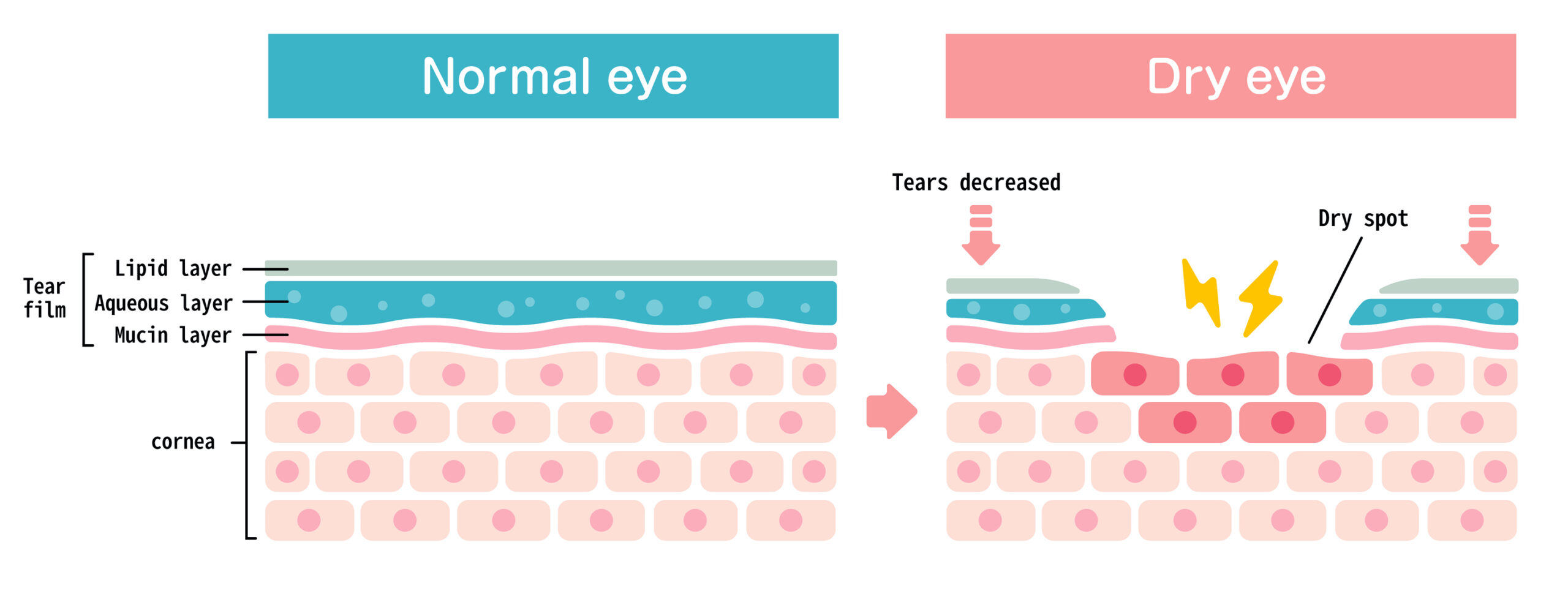
When you blink, a film of tears spreads over the eye, making the surface of the eye smooth and clear. Without this tear film, good vision would not be possible. Sometimes people don’t produce enough tears or the right quality of tears to keep their eyes healthy and comfortable. This condition is known as dry eye.
The tear film consists of three layers: an oily layer, a watery layer and a layer of mucus. Each layer has its own purpose. The oily layer, produced by the meibomian glands, forms the outermost surface of the tear film. Its main purpose is to smooth the tear surface and reduce the evaporation of tears. The middle watery layer makes up most of what we ordinarily think of as tears. This layer, produced by the lacrimal glands in the eyelids, cleanses the eye and washes away foreign particles or irritants. The inner layer consists of mucus produced by the conjunctiva. Mucus allows the watery layer to spread evenly over the surface of the eye and helps the eye remain moist. Without mucus, tears would not stick to the eye.
Normally, the eye constantly bathes itself in tears. By producing tears at a slow and steady rate, the eye stays moist and comfortable. The eye uses two different methods to produce tears. It can make tears at a slow, steady rate to maintain normal eye lubrication. It can also produce a lot of tears in response to eye irritation or emotion. When a foreign body or dryness irritates the eye, or when a person cries, excessive tearing occurs. It may not sound logical that dry eye would cause excess tearing, but think of it as the eye’s response to discomfort. If the tears responsible for maintaining lubrication do not keep the eye wet enough, the eye becomes irritated. Eye irritation prompts the lacrimal gland to release a large volume of tears, overwhelming the tear drainage system. These excess tears then overflow from your eye.
Hormonal changes are the main cause of dry eye syndrome, causing changes in tear production. The hormonal changes associated with menopause are one of the main reasons why women are most often affected by dry eye. Conditions that affect the lacrimal gland or its ducts, including autoimmune diseases like lupus and rheumatoid arthritis, can lead to decreased tear secretion and dry eye. Tear secretion also may be reduced by certain conditions that decrease corneal sensation. Diseases such as diabetes and herpes zoster are associated with decreased corneal sensation. Long-term contact lens wear and surgery that involves making incisions in or removing tissue from the cornea (such as LASIK), can also reduce tear production. People who are sensitive to certain climates such as windy, dry air or to environmental factors like cigarette smoke or air conditioning may develop dry eye when they are exposed to these conditions. Because people who work long hours at a computer are less likely to blink often, they are more susceptible to getting dry eye than people who do not spend a lot of time in front of a computer monitor or other electronic screen.

A wide variety of common medications, both prescription and over-the-counter, can cause dry eye by reducing tear secretion. Be sure to tell your ophthalmologist about all the medications you are taking, especially if you are using:
Since these medications are often necessary, the dry eye condition may have to be tolerated or treated with eye drops called artificial tears. People with dry eye are often more likely to experience the side effects of eye medications, including artificial tears. For example, the preservatives in certain eye drops and artificial tear preparations can irritate the eye. These people may need special, preservative-free artificial tears.
There is no cure for dry eye. Treatment for dry eye consists of three options which can be used separately or in various combinations. The mainstay of treatment is tear replacement, which consists of the use of over-the-counter preparations designed to mimic one’s own natural tears. There are many different types of tear replacement solutions. It is best to speak with your doctor for specific recommendations. If tear replacement is not sufficient, patients may also need to use Restasis for treatment of the condition. Restasis is the only drug of its kind and is available only by prescription. Finally, tear retention devices (such as punctum plugs) can be used to slow down the normal rate at which tears drain away from the surface of the eye through the lacrimal drainage system. Your doctor can help you determine which of these treatments is right for you.

LipiFlow® is an advanced dry eye treatment. LipiFlow® helps fight evaporative dry eye symptoms by using heat and gentle massage to encourage the natural production of lipids for your tear film. This treatment has been extremely helpful to our patients in alleviating dry eye symptoms. Many of our patients show signs of improvement just two weeks after LipiFlow® treatment. LipiFlow® is the most convenient and effective form of dry eye treatment. Come to Mississippi Vision to see if LipiFlow® is right for you!
If you are interested in LipiFlow® treatment, call us for an appointment.